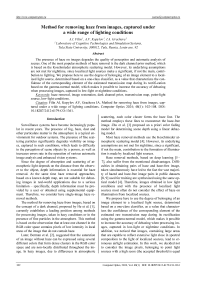Method for removing haze from images, captured under a wide range of lighting conditions
Автор: Filin A.I., Kopylov A.V., Gracheva I.A.
Журнал: Компьютерная оптика @computer-optics
Рубрика: Обработка изображений, распознавание образов
Статья в выпуске: 1 т.48, 2024 года.
Бесплатный доступ
The presence of haze on images degrades the quality of perception and automatic analysis of scenes. One of the most popular methods of haze removal is the dark channel prior method, which is based on the Koschmieder atmospheric scattering model. However, its underlying assumptions are not met for nighttime, since localized light sources make a significant, if not the main, contribution to lighting. We propose here to use the degree of belonging of an image element to a localized light source, determined based on a one-class classifier, as a value that characterizes the confidence of the corresponding element of the estimated transmission map during its rectifi-cation based on the gamma-normal model, which makes it possible to increase the accuracy of dehazing when processing images, captured in low-light or nighttime conditions.
Haze removal, image restoration, dark channel prior, transmission map, point-light source, low-light conditions
Короткий адрес: https://sciup.org/140303264
IDR: 140303264 | DOI: 10.18287/2412-6179-CO-1361
Список литературы Method for removing haze from images, captured under a wide range of lighting conditions
- He K, Sun J, Tang X. Single image haze removal using dark channel prior. IEEE Trans Pattern Anal Mach Intell 2011; 33: 2341-2353. DOI: 10.1109/TPAMI.2010.168.
- Berman D, Avidan S, Treibitz T. Non-local image dehazing. 2016 IEEE Conf on Computer Vision and Pattern Recognition (CVPR) 2016: 1674-1682.
- Zhu Q, Mai J, Shao L. A fast single image haze removal algorithm using color attenuation prior. IEEE Trans Image Process 2015; 24: 3522-3533.
- Koschmieder H. Theorie der horizontalen Sichtweite. Beitr Phys Freie Atmos 1924; 12: 33-55.
- Cai B, Xu X, Jia K, Qing C, Tao D. DehazeNet: An endto- end system for single image haze removal. IEEE Trans Image Process 2016; 25: 5187-5198. DOI: 10.1109/TIP.2016.2598681.
- Qin X, Wang Z, Bai Y, Xie X, Jia H. FFA-Net: Feature fusion attention network for single image dehazing. Proc AAAI Conf on Artificial Intelligence 2020; 34: 11908-11915.
- Zhang S, He F, Ren W. NLDN: Non-local dehazing network for dense haze removal. Neurocomputing 2020; 410: 363-373. DOI: 10.1016/j.neucom.2020.06.041.
- Ancuti C, Ancuti CO, De Vleeschouwer C. D-HAZY: A dataset to evaluate quantitatively dehazing algorithms. 2016 IEEE Int Conf on Image Processing (ICIP) 2016: 2226-2230. DOI: 10.1109/ICIP.2016.7532754.
- Li B, Ren W, Fu D, Tao D, Feng D, Zeng W, Wang Z. Benchmarking single-image dehazing and beyond. IEEE Trans Image Process 2018; 28: 492-505.
- Filin A, Gracheva I, Kopylov A, Seredin O. Fast channeldependent transmission map estimation for haze removal with localized light sources. In Book: Dang NHT, Zhang Y-D, Tavares JMRS, Chen B-H, eds. Artificial intelligence in data and big data processing: Proceedings of ICABDE 2021. Cham, Switzerland: Springer; 2022: 461-471.
- Tax DMJ, Duin RPW. Support vector data description. Mach Learn 2004; 54: 45-66.
- Gracheva I, Kopylov A. Image processing algorithms with structure transferring properties on the basis of gammanormal model. In Book: Ignatov DI, Khachay MYu, Labunets VG, Loukachevitch N, Nikolenko SI, Panchenko A, Savchenko AV, Vorontsov K, eds. Analysis of images, social networks and texts. Cham, Switzerland: Springer International Publishing AG; 2017: 257-268. DOI: 10.1007/978-3-319-52920-2_24.
- Shi LF, Chen BH, Huang SC, Larin AO, Seredin OS, Kopylov AV, Kuo SY. Removing haze particles from single image via exponential inference with support vector data description. IEEE Trans Multimed 2018; 20: 2503-2512. DOI: 10.1109/TMM.2018.2807593.
- Hirschmuller H, Scharstein D. Evaluation of cost functions for stereo matching. 2007 IEEE Conf on Computer Vision and Pattern Recognition 2007: 1-8.
- Li Y, Tan RT, Brown MS. Nighttime haze removal with glow and multiple light colors. 2015 IEEE Int Conf on Computer Vision (ICCV) 2015: 226-234. DOI: 10.1109/ICCV.2015.34.
- Wolf E, ed. Progress in optics. Vol 47. Elsevier; 2005. ISBN: 0-444-51598-4.
- Dhara SK, Roy M, Sen D, Biswas PK. Color cast dependent image dehazing via adaptive airlight refinement and non-linear color balancing. IEEE Trans Circuits Syst Video Technol 2020; 8215: 1-1. DOI: 10.1109/tcsvt.2020.3007850.
- Ancuti C, Ancuti CO, Timofte R, De Vleeschouwer C. IHAZE: A dehazing benchmark with real hazy and hazefree indoor images. In Book: Blanc-Talon J, Helbert D, Philips W, Popescu D, Scheunders P, eds. Advanced concepts for intelligent vision systems. Cham, Switzerland: Springer Nature Switzerland AG; 2018: 620-631. DOI: 10.1007/978-3-030-01449-0_52.
- Ancuti CO, Ancuti C, Timofte R, De Vleeschouwer C. OHAZE: A dehazing benchmark with real hazy and hazefree outdoor images. 2018 IEEE/CVF Conf on Computer Vision and Pattern Recognition Workshops (CVPRW) 2018: 867-875. DOI: 10.1109/CVPRW.2018.00119.
- Filin A, Kopylov A, Seredin O, Gracheva I. Hazy images dataset with localized light sources for experimental evaluation of dehazing methods. 6th Int Workshop on Deep Learning in Computational Physics 2022: 19.
- Filin A, Kopylov A, Gracheva I. Asingle image dehazing dataset with low-light real-world indoor images, depth maps and infrared images. Int Arch Photogramm Remote Sens Spat Inf Sci 2023; 48: 53-57.


